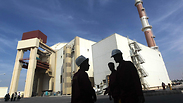
US to Iran: Disconnect, don't dismantle centrifuges
Obama administration considering offering Tehran compromise where it would only remove pipes connecting nuclear centrifuges rather than completely dissembling them.
WASHINGTON - The United States is trying a new approach in nuclear talks with Iran: instead of pressing the country to destroy thousands of centrifuges for which it paid billions of dollars, Iran would only be required to remove the pipes that connect the nuclear centrifuges, according to a New York Times report.
In this way, the Iranians could claim that they did not give in to the demands of the West, maintaining their national pride. The Americans, for their part, would be able to keep the Islamic Republic from building a nuclear bomb.
American experts estimated that disconnecting the centrifuges, which are used for enriching uranium, would increase the period of time required for Iran to potentially produce enough fuel for a nuclear warhead. The delay would give Western countries a "window of response" in the event of the country's reconnection of the centrifuges. An Obama administration official admitted that the White House is "open" to the idea, the NYT reported.
Related stories:
- Iran offers to help in fight against IS in return for flexibility on nuclear program
- Diplomats: Iran receptive to new nuke proposal
- Iran is much more dangerous than ISIS
The number of nuclear centrifuges has emerged as the principal sticking point in negotiations, which are expected to continue in New York until at least Sept. 26.
Centrifuges are machines that spin at supersonic speed to increase the ratio of the fissile isotope in uranium. Low-enriched uranium is used to fuel nuclear power plants, Iran's stated goal, but can also provide material for bombs if refined much further, which the West fears may be Iran's latent goal.
Iran currently has over 19,000 centrifuges, though only around 10,000 of those are operational. The six powers want Iran to reduce the number of operational centrifuges to the low thousands, to ensure it cannot quickly produce enough bomb-grade uranium for a weapon, should it choose to do so.
According to the NYT report, the initiative to convince the Iranians to disconnect their network of pipes that connect the centrifuges is only "one of the few ideas" that have come up for discussion on the nuclear negotiating table in New York.
The new American proposal is still under discussion, but has already been the subject of heated critique. “To be credible, it would have to keep the Iranians from restoring operations for a considerable period of time,” the NYT quoted Robert Einhorn, a former top US Iran arms control advisor, as saying.
“Unless the Iranians are talking about reducing their currently operational enrichment capability by around a half, it is not very impressive,” Einhorn said..
According to the Daily Beast, 31 senators issued a letter to US Secretary of State John Kerry, saying that they are against the US administration's "creative idea".
“Given that a nuclear Iran poses the greatest long-term threat to the security of the United States, Israel, and other allies, we are gravely concerned about the possibility of any new agreement that, in return for further relief of US-led international sanctions, would allow Iran to produce explosive nuclear material,” the Daily Beast quoted the letter as saying..
Iranians are keen to keep as many of their centrifuges as possible, and have also suggested that they could keep all 19,000 installed while maintaining a much smaller number in an operational state. Western officials say they dislike that idea.
US officials have made clear for months that the number of centrifuges they are willing to tolerate operating in Iran over the medium term would be in the low thousands to ensure that Tehran's ability to produce a usable amount of bomb-grade uranium, should it go down that road, is severely limited.
Iran says such draconian limitations would be a violation of its right to enrich. Supreme Leader Khamenei has called that issue a "red line" for Tehran.
Centrifuges are not the only sticking point in the talks. Others include the duration of any nuclear deal, the timetable for ending the sanctions, and the fate of a research reactor that could yield significant quantities of bomb-grade plutonium.
Under a November 2013 interim deal, Iran froze some parts of its atomic program in exchange for limited sanctions relief. That agreement was intended to buy time for negotiations on a comprehensive deal that end the decade-long standoff with Iran and remove the risk of yet another war in the Middle East.
Reuters contributed to this report.











